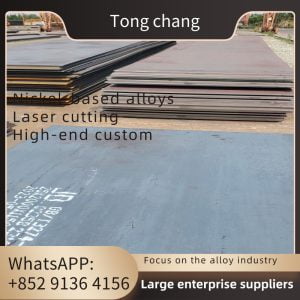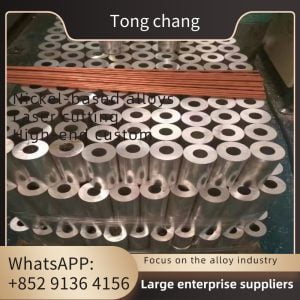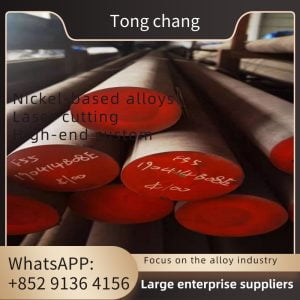| Material Grade: | S31803 | Standard: | ASTM A789/ASME SA789 |
|---|---|---|---|
| Type: | Seamless | NDT: | ET, HT, UT |
| Application: | Industry,boiler,Chemical | Technique: | Cold Rolled/Cold Drawn |
| High Light: | Boiler Stainless Steel Round Tube, Duplex 2205 Steel Seamless Tube, Oil Gas Stainless Steel Seamless Tubing | ||
A789/SA789 S31803 DUPLEX 2205 SEAMLESS TYPE HEAT EXCHANGE TUBES
Duplex stainless steels are called “duplex” because they have a two-phase microstructure consisting of grains of ferritic and austenitic stainless steel. The picture shows the yellow austenitic phase as “islands” surrounded by the blue ferritic phase. When duplex stainless steel is melted it solidifies from the liquid phase to a completely ferritic structure. As the material cools to room temperature, about half of the ferritic grains transform to austenitic grains (“islands”). The result is a microstructure of roughly 50% austenite and 50% ferrite.
Whilst duplex stainless steel are considered resistant to stress corrosion cracking, they are not as resistant to this form of attack as ferritic stainless steel. However, the corrosion resistance of the least resistant Duplex stainless steel is greater than that for the most commonly used grades of stainless steel, i.e. 304 and 316.
Duplex stainless steel are also magnetic, a property that can be used to easily differentiate them from common austenitic grades of stainless.
This aside, the alloy of ASTM A789 UNS S31803 is a cost-effective solution for many purposes, especially since stainless steels belonging to 300 series tend to be sensitive to chloride ion stress related corrosion cracking. The ASTM A789 is a specification which satisfies approved requirements for grades of nominal wall thickness, duplex pipes for those applications which require properties such as – resistance to general corrosion. The specification also places critical emphasis on the resistance of ASTM A789 UNS S32205 to stress related corrosion cracking.
Chemical Composition
| Grade | C | Mn | Si | P | S | Cr | Mo | Ni | N | |
| 2205 (UNS S31803) | Min Max | – 0.030 | – 2.00 | – 1.00 | – 0.030 | – 0.020 | 21.0 – 23.0 | 2.5 – 3.5 | 4.5 – 6.5 | 0.08 – 0.20 |
| 2205 (UNS S32205) | Min Max | – 0.030 | – 2.00 | – 1.00 | – 0.030 | – 0.020 | 22.0 – 23.0 | 3.0 – 3.5 | 4.5 – 6.5 | 0.14 – 0.20 |
Mechanical Composition
| Grade | Tensile Strength (MPa) min | Yield Strength 0.2% Proof (MPa) min | Elongation (% in 50mm) min | Hardness | |
| Rockwell C (HR C) | Brinell (HB) | ||||
| UNS S32205/ Duplex 2205 | 621 | 448 | 25 | 31 max | 293 max |
Physical Properties
| Grade | Density (kg/m3) | Elastic Modulus (GPa) | Mean Co-eff of Thermal Expansion (μm/m/°C) | Thermal Conductivity (W/m.K) | Specific Heat 0-100°C ( J/kg.K) | Electrical Resistivity (nΩ.m) | |||
| 0-100°C | 0-315°C | 0-538°C | at 100°C | at 500°C | |||||
| UNS S32205/ Duplex 2205 | 782 | 190 | 13.7 | 14.2 | – | 19 | – | 418 | 850 |
Grade Specification Comparison
| Grade | UNS No | Old British | Euronorm | Swedish SS | Japanese JIS | ||
| BS | En | No | Name | ||||
| 2205 | S31803/S32205 | 318S13 | – | 1.4462 | X2CrNiMoN22-5-3 | 2377 | SUS 329J3L |
Possible Alternative Grades
| Grade | Reasons for choosing the grade |
| 904L | Better formability is needed, with similar corrosion resistance and lower strength. |
| UR52N+ | High resistance to corrosion is required, e.g. resistance to higher temperature seawater. |
| 6%Mo | Higher corrosion resistance is required, but with lower strength and better formability. |
| 316L | The high corrosion resistance and strength of 2205 are not needed. 316L is lower cost. |
Application:
- Petroleum
- Chemical industry
- Instrument
- Industrial transportation
- Mechanical structure industry
- Need high corrision ability pipe's industry, such as offshore industry etc
Advantages:
- Superior surface finish,
- Better mechanical property
- More precise dimension
- Perfect inspection method and inspection equipment








